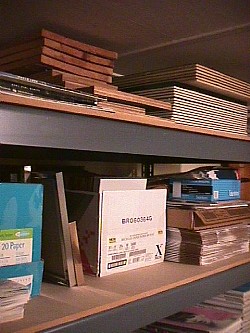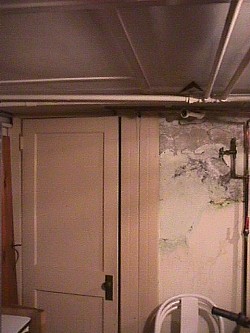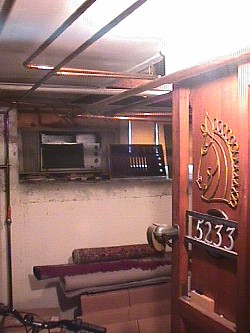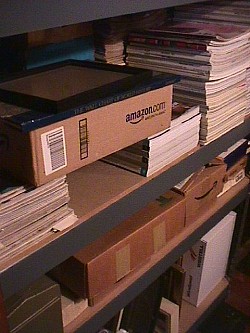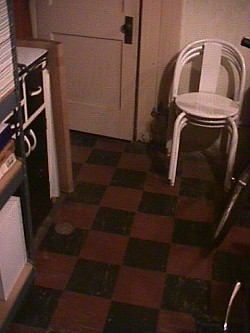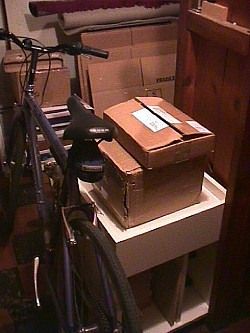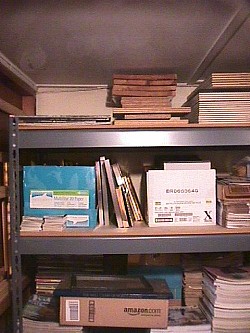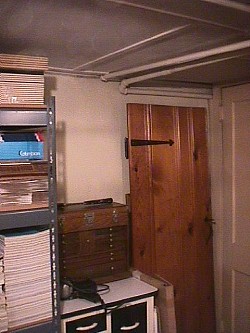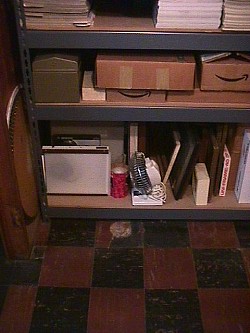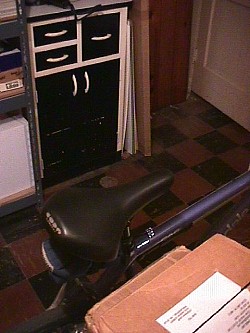2005.03.23 12:17
Re: new Trumbauer fan (system)
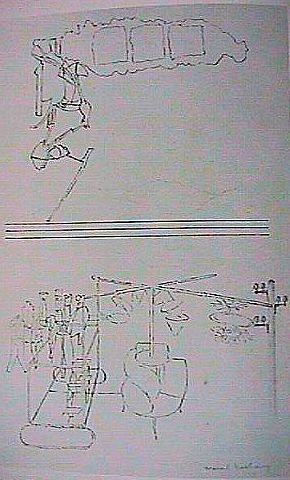
| |
Saw this artwork last night as I continued to read Étant donnés... (by d'Harnoncourt and Hopps).
"Another "landscape" which Duchamp produced in 1959, forms a tantalizing link between The Large Glass and Étant donnés... . The punning title Cols Alités, is amplified by a startling inscription: "Projet pour le modèle 1959 de 'La Mariée mise à nu par ses célibataires, même'" The drawing is more startling still. Duchamp has drawn a background for his Glass! The basic elements of the Glass, including three parallel lines across the middle representing the Bride's Clothes, are drawn in ink, and behind them, apparently lightly sketched in pencil, rise the irregular rolling forms of a hilly landscape. To the right, just tangent to on blade of the Scissors atop the chocolate Grinder, Duchamp has added an electrical pole, the common variety that punctuates the countryside everywhere, complete with glass insulating knobs and wires disappearing in the distance.
. . . . .
For it is impossible not to take the view of undulating hills and the explicit electrical pole, with the title pun to "Causalités," as a broad hint at the assemblage [i.e., Étant donnés] that was gradually nearing completion in the Fourteenth Street studio. The pole its wires reads in retrospect as a direct reference to the "electricity at large," which now performs a practical function in the new tableau."
=====
I can't read French, so I don't know what Duchamp's inscription says. Nonetheless, it's evident that Duchamp (too) thought about the presence of electricity everywhere.
I'm seeing this work as another link (albeit minuscule) between where Duchamp's work mostly is now (i.e., the Philadelphia Museum of Art) and the collection's prime location at the head of the Benjamin Franklin Parkway.
=====
Was at the Philadelphia Museum of Art yesterday taking pictures--was there Sunday as well, but only scoped out what I'd rather photograph on a sunny day. Some very nice axial coincidences were there to be recorded, which is great because "Nudist Camp at the Philadelphia Museum of Art" centers on the axial coincidence of Jennewein's Sacred and Profane Love and the Duchamp collection, especially The Large Glass.
I haven't seen the Dali exhibit yet, put the public video gallery is now playing, along with Un Chien Andalou, Destino (a Dali - Disney 1945 'collaboration' completed 2003). Destino is a joy to watch, and, though I'm generally not crazy about Disney animation, the animated imagery is great via Dali's imagination. I took about 2 dozen still of the video and will post them soon.
| |
2005.03.23
fallout from the confirmation
I can now begin to see all my work (almost whatever I do each day even) as the potential for some object or thing that constitutes a (sellable) work of art. The objects can have a Duchamp meets Cornell character, like Cornell with a teleology. I really do that already, and I’ve wanted to do that with the Artifacts of Ottopia all along, but now the concept is tighter because the narrative is now so much more real.
Perhaps the greatest conflict lies in me wanting to continue producing via whim or me producing very specifically and more intently. In the second approach some projects will surely fall by the wayside (as if a lot of projects don’t do that already). I like the notion of my work being an ongoing series of clues and manifestations of a deliberate system--that’s what I see as most Duchamp. Yet there is every possibility that my work will have the greatest impact on architecture. I guess what I really should do is compose works that are pseudo scientific, scholarly yet mysterious, hidden meaning and also mixing odd things up. The one thing I have that Duchamp and Cornell never had is cad, and all the drawings that go with that.
Should it be my aim to tackle the abundance?
| |
2005.03.24 14:32
Re: Preserving listed buildings - on computer
I probably shouldn't give away too many of my ideas, but what the hell. I few years ago I thought I could offer virtual dream mansions on eBay. The gist of the idea was for me to advertise virtual architectural design services and the prospective client would receive a set of drawings/rendering of a fantastic house design. The client could then frame the drawings and tell all their friends they've had a mansion designed specifically for them. Of course, once a winning bid was had, I'd then further tempt the clients with extras, like a 'royal' bathroom suite or a 5 car garage cum carwash. Every mansion would have a room-size vault though.
(title in 45 letters or less)
WHEN A REAL HOUSE JUST ISNT ENOUGH GO VIRTUAL
I thought Neuschwanstein would look different inside. It looked too new or something.
Linderhof seemed cramped inside due to the overabundance of ornament.
Aalto's Baker House seemed cramped inside too, but that was because it was.
Le Corbusier's Carpenter Center was fun to see, but it also reminded me of a lot of models of student designs I've seen. Does a building up on columns somehow have an instant appeal?
The WWII bunker at Cape May Point actually does it all for me.
Now, there are a whole bunch of buildings that I've constructed in CAD and hence visited virtually which haven't disappointed at all.
To be honest, I hope everyone goes crazy over the prospect of "preserving listed buildings--on computer" because I believe everyone should get what they deserve.
Hey, does anyone else think it would be cool to see a reenactment of the 1939-40 New York World's Fair Trilon and Perisphere at Ground Zero?
| |
2005.03.27 13:38
moving along (down the Parkway)
There were claims that Duchamp suggested the mobile form to Calder. In the thirties, Calder was in Paris, making his wire portraits of Josephine Baker and others. Clay Spohn, a very curious artist from San Francisco who was a conceptual bricoleur and who did some of the first assemblage art in California, was also in Paris at that time, and he knew both Calder and Duchamp. Spohn told me that he had actually been the one to suggest the idea of the mobile to Calder. I had heard that it was Duchamp, and asked Marcel about that. He laughed and said, "Oh, people have always misunderstood. Spohn, this strange American whom I enjoyed very much, suggested to Calder that he take the little parts and balance them on wires to make these contraptions. What I did was to name it. What I invented was the word mobile."
Walter Hopps, "Gimme Strength: Joseph Cornell and Marcel Duchamp Remembered" in Joseph Cornell/Marcel Duchamp ...In Resonance (Houston: Menil Foundation, Inc., 1998), p. 74
|

